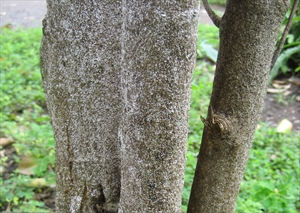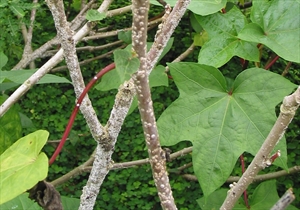White peach scale; also known as the mulberry scale
Pacific Pests, Pathogens and Weeds - Online edition
Pacific Pests, Pathogens & Weeds
Cassava white peach scale (052)
Pseudaulacaspis pentagona
Asia, Africa, North, South and Central America, the Caribbean, Europe, Oceania. It is recorded from Australia, Guam, Federated States of Micronesia, New Caledonia, New Zealand, Northern Mariana Islands, Fiji, Palau, Papua New Guinea, Samoa, Solomon Islands, Tonga, Vanuatu, and Wallis & Futuna.
In Pacific island countries, it is common on bele, chilli, capsicum, cassava, and passionfruit. It has also been found causing heavy infestations on paper mulberry (Broussonetia sp.) on Guadalcanal, Solomon Islands (Photo 1). Mulberry is a main host, and paper mulberry is in the same family.
The scale feeds on plant sap, and infestations on passionfruit cause yellow leaves, small fruit, and premature fruit drop. Heavy infestations can result in stunting (cassava), and the death of branches and dieback (chilli and capsicum).
Egg laying begins 2 weeks after mating, and about 100 eggs are laid over 8-9 days. The first eggs laid become female; those laid later become male. 'Crawlers' emerge after 3-4 days.
The crawlers have three pairs of legs and prominent antennae. The females are more active and wander further than the males. After about 12 hours, they settle down to feed, and go through two moults before they become adult. Females are covered by a roughly circular protective covering, called the armour, about 2-2.5 mm across (Photo 2); beneath the scale is the insect itself, 0.8-0.9 mm long, pink to yellow, and without legs. Males begin building their armour after their second moult; theirs is a long white to yellowish coloured shell. They moult three more times, eventually emerging as an orange coloured adult and living only 24 hours. Unlike females of this species, adult males possess wings in order to find females and mate, attracted by chemicals (pheromones). The adult male body length is approximately 0.7 mm with a 1.4 mm wingspan. They do not have mouthparts, and do not feed.
Spread is by crawlers on the wind, and infested cuttings used for planting. The life cycle lasts about 45 days (see Fact Sheet no. 52).
The scale is often seen in large numbers on the bottom of stems; there are often so many that farmers think the mass of insects is a white fungus on the plants (Photos 3&4). When they occur in large numbers like that it is likely that crop yields are affected, but there have been few studies to detail losses. In Samoa, damage to passionfruit was so severe what biocontrol agents were introduced to manage the scale.
Look for the heavy infestations that occur as thick crusts on stems or tree trunks. Leaves and fruits are not usually colonised. The white colonies of females and males are easy to recognise when infestations are high.
NATURAL ENEMIES
Species of ladybird beetles and lacewings are known to feed on white peach scale in other parts of the world and probably these insects do the same in Pacific island countries. Encarsia diaspidicola, an aphelinid parasitoid wasp, has been successfully released in Samoa, and more recently in Hawaii, with good results. In addition, the encyrtid wasp Encasia berlesei has also been used to controlwhite peach scale populations. It is present in Tonga, and Waterhouse records that two strains, "from Europe and Tonga, were liberated in Western Samoa in 1986, with unknown results". Another Encasia species, from Florida was also introduced to (Western) Samoa, and "was causing at least 50% mortality within a few months".
CULTURAL CONTROL
Before planting:
- Do not plant cuttings infested with white peach scale.
- Avoid planting new crops downwind from those infested with the scale, as the crawlers will spread to the new crop on the wind.
During growth:
- Cut out stems of plants that become infested with white peach scale and burn them.
After harvest:
- Collect and burn stems and other parts infested with the scale.
CHEMICAL CONTROL
Insecticides should be avoided, unless control by natural enemies is ineffective. Note, too, insecticides are not always effective against females, as they live under a protective scale of wax.
- However, if necessary, use white oil (made from vegetable oils), soap solution, or horticultural oil (made from petroleum) (see Fact Sheet no. 56).
- White oil:
- 3 tablespoons (1/3 cup) cooking oil in 4 litres water.
- ½ teaspoon detergent soap.
- Shake well and use
- Soap:
- Use soap (pure soap, not detergent).
- 5 tablespoons of soap in 4 litres water, OR
- 2 tablespoons of dish washing liquid in 4 litres water.
- White oil:
- Commercial horticultural oil can also be used. White oil, soap and horticultural oil sprays work by blocking the breathing holes of insects causing suffocation and death. Spray the undersides of leaves; the oils must contact the insects. A second application of soap or oils may be necessary after 3-4 weeks.
- The addition of malathion is useful against scales insects, but it is likely to kill natural enemies.
- Synthetic pyrethroid insecticides are likely to be effective against the crawlers - crawlers are the active nymphs that spread infestations to new plants and/or new gardens, but they are difficult to see as they are so small. And synthetic pyrethroids are likely to kill natural enemies.
____________________
When using a pesticide, always wear protective clothing and follow the instructions on the product label, such as dosage, timing of application, and pre-harvest interval. Recommendations will vary with the crop and system of cultivation. Expert advice on the most appropriate pesticides to use should always be sought from local agricultural authorities.
AUTHORS Helen Tsatsia & Grahame Jackson
Information from Waterhouse DF, Norris KR (1987) Pseudaulacaspis pentagona (Targioni-Torzzetti). Biological Control Pacific Prospects. Inkata Press. Assistance. Photos 2&4 Graham Teakle, Canberra; and CABI (2020) Pseudaulacaspis pentagona (mulberry scale). (https://www.cabi.org/cpc/datasheet/45077); Branscome D (2019) Pseudaulacaspis pentagona (Targioni). Featured Creatures, Entomology & Nematology. UF/IFAS, University of Florida. (http://entnemdept.ufl.edu/creatures/orn/scales/white_peach_scale.htm).
Produced with support from the Australian Centre for International Agricultural Research under project PC/2010/090: Strengthening integrated crop management research in the Pacific Islands in support of sustainable intensification of high-value crop production, implemented by the University of Queensland and the Secretariat of the Pacific Community.







